- Home
- About
- Map
- Trips
- Bringing Boat West
- Migration West
- Solo Motorcycle Ride
- Final Family XC Trip
- Colorado Rockies
- Graduates' XC Trip
- Yosemite & Nevada
- Colorado & Utah
- Best of Utah
- Southern Loop
- Pacific Northwest
- Northern Loop
- Los Angeles to NYC
- East Coast Trips
- Martha's Vineyard
- 1 Week in Quebec
- Southeast Coast
- NH Backpacking
- Martha's Vineyard
- Canadian Maritimes
- Ocracoke Island
- Edisto Island
- First Landing '02
- Hunting Island '02
- Stowe in Winter
- Hunting Island '01
- Lake Placid
- Chesapeake
- Provincetown
- Hunting Island '00
- Acadia in Winter
- Boston Suburbs
- Niagara Falls
- First Landing '99
- Cape Hatteras
- West Coast Trips
- Burning Man
- Utah Off-Roading
- Maui
- Mojave 4WD Course
- Colorado River Rafting
- Bishop & Death Valley
- Kauai
- Yosemite Fall
- Utah Off-Road
- Lost Coast
- Yosemite Valley
- Arizona and New Mexico
- Pescadero & Capitola
- Bishop & Death Valley
- San Diego, Anza Borrego, Joshua Tree
- Carmel
- Death Valley in Fall
- Yosemite in the Fall
- Pacific Northwest
- Utah Off-Roading
- Southern CA Deserts
- Yosemite & Covid
- Lake Powell Covid
- Eastern Sierra & Covid
- Bishop & Death Valley
- Central & SE Oregon
- Mojave Road
- Eastern Sierra
- Trinity Alps
- Tuolumne Meadows
- Lake Powell Boating
- Eastern Sierra
- Yosemite Winter
- Hawaii
- 4WD Eastern Sierra
- 4WD Death Valley +
- Southern CA Deserts
- Christmas in Tahoe
- Yosemite & Pinnacles
- Totality
- Yosemite & Sierra
- Yosemite Christmas
- Yosemite, San Diego
- Yosemite & North CA
- Seattle to Sierra
- Southwest Deserts
- Yosemite & Sierra
- Pacific Northwest
- Yosemite & South CA
- Pacific Northwest
- Northern California
- Southern Alaska
- Vancouver Island
- International Trips
- Index
- Tips
- Books
- Photos/Videos
- Search
- Contact
Galapagos - Santiago Island, Ecuador
Sunday, March 19, 2023 - 8:15am by Lolo
0 miles and 0 hours from our last stop - 1 night stay
Travelogue
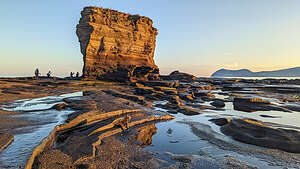 Puerto Egas beachWe slept through another overnight cruise south to the island of Santiago, a somewhat barren island with mostly volcanic landscape.
Puerto Egas beachWe slept through another overnight cruise south to the island of Santiago, a somewhat barren island with mostly volcanic landscape.
Originally named James Island, Santiago was the second of the Galapagos Islands visited by Charles Darwin in 1835. The island had already long been a source of freshwater, wood, and tortoises for buccaneers and whalers for two centuries.The easy-to-catch Giant Tortoises that lived here became a useful source of protein for the sailors. Between 1784 and 1860, whalers took more than 100,000 tortoises from the Galapagos islands, which they kept alive on their ships until ready to eat them
 Puerto Egas beachToday, it’s only visitors are tourists, like us.
Puerto Egas beachToday, it’s only visitors are tourists, like us.
After breakfast, we hopped aboard the pangas for a wet landing on Puerto Egas where there was a lovely sand lava beach. As with every other morning, we were the first tour group ashore, and as a result we had the place to ourselves, except, of course, for the marine iguanas happily breakfasting on the exposed algae bed.
We were allowed to run free in either direction - although Galapagos rules required that tourists always remain in sight of their naturalist guide.
 Sally LightfootI, and most of our group, headed right towards a beautiful, volcanic rock formation just beginning to catch the morning light. Herb, who prefers to photograph in smaller groups, headed to the left, where he happily had the sally lightfoot crabs and marine iguanas all to himself.
Sally LightfootI, and most of our group, headed right towards a beautiful, volcanic rock formation just beginning to catch the morning light. Herb, who prefers to photograph in smaller groups, headed to the left, where he happily had the sally lightfoot crabs and marine iguanas all to himself.
The tide was still low enough to go around the backside of the rock formation to an arch, through which there was a lovely view of Sally Lightfoot crabs scurrying along the tidal pools and a brown pelican posing in the distance.
 Marine Iguana greeting the sunMeanwhile, Herb was off by himself at the other end of the beach photographing the beautiful bright red, yellow and blue Sally Lightfoods crabs scampering along the lava rocks just above the surf.
Marine Iguana greeting the sunMeanwhile, Herb was off by himself at the other end of the beach photographing the beautiful bright red, yellow and blue Sally Lightfoods crabs scampering along the lava rocks just above the surf.
They are named for their nimble, “light-footed” motion, up and down and even upside down while scurrying across the rocks. It is rumored that the “Sally” part of their name comes from a Caribbean dancer that displayed a similar exceptional agility when she danced.
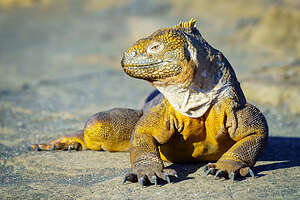 Re-introduced juvenile land iguanaThey would often scoot away when approached, but if you are patient enough and just sit quietly, they will come back out of their hiding place and approach you.
Re-introduced juvenile land iguanaThey would often scoot away when approached, but if you are patient enough and just sit quietly, they will come back out of their hiding place and approach you.
Unlike the flamboyantly colored parents, the juveniles are black, camouflaging them from predators, such as shorebirds, until they develop the speed and agility used by their parents to scoot out of danger.
If someone had told me before this trip that one of our favorite creatures to photograph would be a crab, I would have thought they were crazy, but then we met the Sally Lightfoot crab, and it was love at first sight.
 Rocky volcanic shorelineHerb also found a marine iguana soaking up the first morning rays of the sun. They are cold-blooded and need to absorb the heat from the sun to warm up. They are found much of the day, angling their body to directly face the sun, as if worshiping the sun god.
Rocky volcanic shorelineHerb also found a marine iguana soaking up the first morning rays of the sun. They are cold-blooded and need to absorb the heat from the sun to warm up. They are found much of the day, angling their body to directly face the sun, as if worshiping the sun god.
Herb often does the same.
Herb would have happily stayed there for hours, if Monica hadn’t yelled to him that it was time to move on.
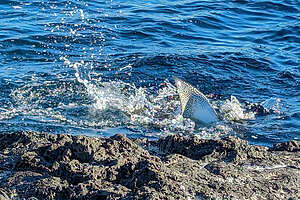 Beautifully patterned stingrayWe left the beach and followed a trail inland through a break in the low ledge adjacent to the sea. Off to the left were the remains of a salt mine from the 1930s, owned by a man named Jorge Egas, hence the name Puerto Egas.
Beautifully patterned stingrayWe left the beach and followed a trail inland through a break in the low ledge adjacent to the sea. Off to the left were the remains of a salt mine from the 1930s, owned by a man named Jorge Egas, hence the name Puerto Egas.
Today, all that remains are some half-ruined buildings and an old soccer field, which has been designated by the National Park Service as one of the only few areas outside of the cities where ship crews are allowed to freely disembark and play for a few hours, to blow off steam from dealing with all those crazy tourists.
 Prehistoric-looking marine iguanaWe met a cute little land iguana along the way.
Prehistoric-looking marine iguanaWe met a cute little land iguana along the way.
Land iguanas had been extinct on Santiago Island since the early 20th century, when feral cats and goats were introduced to the island, killing off many juveniles.
However, after these invasive species were eradicated, in 2019, land iguanas were reintroduced to the island. They were moved from North Seymour island (where we first saw them) where there were over 5,000 of them, too many for the available food on the island. A win-win situation for the two islands.
Three years later, a new generation of newborn and juvenile iguanas are thriving, and today we got to meet one.
 Yellow-crowned night heronThe trail eventually led out onto a rocky volcanic formation along the shoreline with a deep pool informally known as “Darwin’s Toilet, because it fills and empties rapidly with seawater rushing in from underground tunnels.
Yellow-crowned night heronThe trail eventually led out onto a rocky volcanic formation along the shoreline with a deep pool informally known as “Darwin’s Toilet, because it fills and empties rapidly with seawater rushing in from underground tunnels.
We saw a poor sea lion down in the pool that had a fishing line wrapped around his head with the hook still caught in his mouth. There was nothing anyone could do to help him. The rules are very strict in the Galapagos about interfering with the animals in any way. Plus sea lions have very large teeth and have been known to bite and even hospitalize good Samaritans that try to come to their aid.
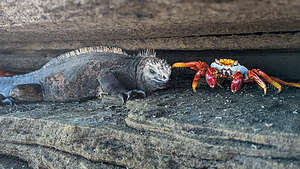 Feisty Sally Lightfoot poking a Marine IguanaFrom the rocks we spotted a stingray with a beautiful pattern on its fins and a large marine iguana swimming in the sea.
Feisty Sally Lightfoot poking a Marine IguanaFrom the rocks we spotted a stingray with a beautiful pattern on its fins and a large marine iguana swimming in the sea.
The diet of marine iguanas is primarily green and red algae. While females and smaller marine iguanas feed intertidally on exposed rocks, the larger males forage on the bottom of the sea. They are the only lizards in the world that are capable of doing this. The bigger males are great divers that can slow their metabolism down to stay submerged for up to an hour.
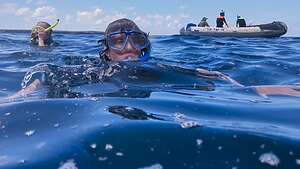 Snorkeling time!Their blunt snouts make it easier to nibble the thin layer of red and green algae found on the rocks.
Snorkeling time!Their blunt snouts make it easier to nibble the thin layer of red and green algae found on the rocks.
Over the next few days, and even snorkeling with them, they started to grow on me. Maybe they were kind of cute in their own way.
We also met a yellow-crowned night heron, very much awake, unlike the one we saw yesterday on Genovesa.
 Hieroglyphic HawkfishNext, we came upon some more Sally Lightfood crabs tucked into the cracks of the rocky ledges that lined our path. They seemed perfectly at home with the marine iguanas that joined them. In fact, one feisty Sally Lightfoot seemed to taunt a marine iguana by poking him in the side of his head. The bright red, yellows, and blues of the crab next to the deep black of the marine iguana made for a stunning contrast.
Hieroglyphic HawkfishNext, we came upon some more Sally Lightfood crabs tucked into the cracks of the rocky ledges that lined our path. They seemed perfectly at home with the marine iguanas that joined them. In fact, one feisty Sally Lightfoot seemed to taunt a marine iguana by poking him in the side of his head. The bright red, yellows, and blues of the crab next to the deep black of the marine iguana made for a stunning contrast.
I love watching and photographing the way the species interact with each other so casually - vulture ground finches riding on the back of marine iguanas, colorful reef fish nibbling at the algae on sea turtles, and these Sally Lighfood crabs teasing the marine iguanas.
 Fiddler CrabWhat an incredible morning it had been, and it was only 9:00 a.m.
Fiddler CrabWhat an incredible morning it had been, and it was only 9:00 a.m.
We returned to the boat, got on our wetsuits, and headed back out on the pangas for our daily snorkeling.
One of the strangest fish we saw just lying there hiding amongst some rocks was a hieroglyphic hawkfish, dressed in complete camo garb of stripes and bands, which actually do look a little like hieroglyphics. He just hangs out disguised in the rocks, waiting for dinner to come by. There were also schools of colorful fish, including the pin-striped group, which I was unable to identify.
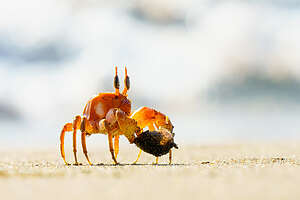 Ghost CrabAfter an hour of snorkeling, we went back to the boat for lunch and a siesta. Free time at last! Herb napped, and I finally got a chance to just sit in an upper deck lounge chair and read a book. However, I must confess I did close my eyes for a bit.
Ghost CrabAfter an hour of snorkeling, we went back to the boat for lunch and a siesta. Free time at last! Herb napped, and I finally got a chance to just sit in an upper deck lounge chair and read a book. However, I must confess I did close my eyes for a bit.
Fed and rejuvenated, we headed back out on the pangas for a landing on Playa Espumilla, a golden sandy beach where every year female sea turtles come in early March to nest.
We saw several of their nests, which were deep, wide holes dug into the sand up near the mangroves, but unfortunately they were empty.
 Dolphins joining us on our panga rideHowever, one lucky person in our group did see a tiny baby one crawl across the beach and successfully make it to the sea. Someday he would return to this very same beach to nest.
Dolphins joining us on our panga rideHowever, one lucky person in our group did see a tiny baby one crawl across the beach and successfully make it to the sea. Someday he would return to this very same beach to nest.
Beyond the beach there was a trail that led through a grove of mangroves to a saline lagoon. Alongside the lagoon we found several collections of sea turtle bones. We also found two new interesting crabs: the fiddler and the ghost.
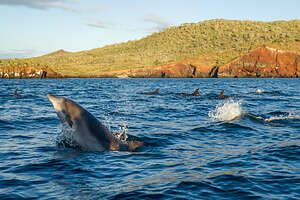 Our dolphin escortsLike the fiddler crabs we have seen in South Carolina, the male has a giant claw which he carries around like a cello - so I nicknamed him Yo-Yo Ma. During courtship, he waves it around to attract females - the fiddler crab that is, not Yo-Yo Ma. They’re kind of hard to photograph, because as soon as they feel the vibration of approaching footsteps, they quickly disappear into their sand burrows.
Our dolphin escortsLike the fiddler crabs we have seen in South Carolina, the male has a giant claw which he carries around like a cello - so I nicknamed him Yo-Yo Ma. During courtship, he waves it around to attract females - the fiddler crab that is, not Yo-Yo Ma. They’re kind of hard to photograph, because as soon as they feel the vibration of approaching footsteps, they quickly disappear into their sand burrows.
The other crab was a Ghost Crab, which Herb was very lucky to photograph, because, as their name implies, they are very elusive and nocturnal. Usually, you only see their tiny eyes at the end of movable stalks peering out from their burrows. Herb got him strutting right out in the open. He looked like a tiny lunar module.
 Volcanic cliffs along Buccaneer CoveI can’t believe I am starting to love crabs so much. They are actually quite beautiful when you get up close.
Volcanic cliffs along Buccaneer CoveI can’t believe I am starting to love crabs so much. They are actually quite beautiful when you get up close.
Back out on the beach we met a pair of oystercatchers patrolling the beach for food. Since their food is usually found along the shoreline, they walk rather than fly, and are almost found in pairs.
They are lovely birds with a distinctive black and white plumage, pink legs, and long, bright reddish-orange beaks.
 Volcanic Tower with Opuntia cactusTheir diet consists of bivalves, mollusks, worms, and crustaceans which they dig out using their perfectly adapted strong and powerful beaks. Once in their grasp, they pry open their catch with their beak and quickly slice the strong adductor muscles to get at the meat inside.
Volcanic Tower with Opuntia cactusTheir diet consists of bivalves, mollusks, worms, and crustaceans which they dig out using their perfectly adapted strong and powerful beaks. Once in their grasp, they pry open their catch with their beak and quickly slice the strong adductor muscles to get at the meat inside.
Our last activity of the day was a panga ride along the steep cliffs near Buccaneer Cove, with dolphins accompanying us much of the way.
Buccaneer Cove was a haven for pirates and whalers in the 17th and 18th century. When Darwin first visited here in the Beagle in 1835, he found a party of Spaniards drying fish and salt tortoise meat. The island had already been a source of freshwater, wood, and tortoises for buccaneers and whalers for well over a century.
 Post-sunset return to shipThe volcanic cliffs were beautiful, with layers of eroded tuff volcanic rocks forming amazing shapes. They were a stunning red in the late afternoon light.
Post-sunset return to shipThe volcanic cliffs were beautiful, with layers of eroded tuff volcanic rocks forming amazing shapes. They were a stunning red in the late afternoon light.
Many of the cliffs were topped with tall Opuntia cactus. I am always awed with how persistent plants can be to find a home on what was once bare volcanic rock.
By the time we headed back to our boat, the sun was already setting. That’s why we chose this photo tour - first group onshore in the morning, and last to leave at night.
Recap of wildlife we saw today: marine iguanas, Sally Lightfoot crabs, land iguanas, yellow-crested night heron, sea lions, stingrays, hieroglyphic hawkfish (while snorkeling), oystercatchers, fiddler crabs, ghost crabs, and Galapagos mockingbirds.
- ‹ previous
- 5 of 13
- next ›
Galapagos - Santiago Island location map in "high definition"
Javascript is required to view this map.
